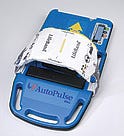Specially engineered load cells offer precision measurement and shock-loading tolerance in harsh field conditions
July 15, 2009
Originally Published MPMN July 2009
ENGINEERING SOLUTIONS
Custom Load Cells Enhance Automated CPR Device
Specially engineered load cells offer precision measurement and shock-loading tolerance in harsh field conditions
Joyce Laird
Click to enlarge |
A redesigned load cell allowed the AutoPulse to adjust to a patient's body for optimal CPR treatment. |
For victims of sudden cardiac arrest (SCA), even the best EMTs may not be able to sustain lifesaving CPR all the way from the point of rescue to the hospital. Able to move blood more consistently than manual CPR, however, the AutoPulse noninvasive cardiac support pump, manufactured by Zoll Circulation Inc. (Sunnyvale, CA; www.zollcirculation.com), delivers uninterrupted chest compressions to maintain myocardial and cerebral perfusion.
Among the AutoPulse’s key features is a load-distributing LifeBand that squeezes the entire chest, improving blood flow to the heart and brain during SCA. The length of this band automatically adjusts to the patient’s size, shape, and weight based on the safety measurements obtained by a weight-sensing load cell. “We tested it in the field to see what worked and what needed improvement,” recalls James Palazzolo, general manager. “The first commercial product had some early success, but the load cell longevity was a challenge.”
Zoll set out to redesign the system with a very specific set of load cell requirements, but several suppliers said that it simply could not be achieved. Sentran LLC (Ontario, CA; www.sentranllc.com), a load cell and force transducer manufacturer, however, was up for the challenge. “We developed a design based on a double-ended bending beam load cell,” says Ken Kramer, president and founder of Sentran. “Many people integrate mechanical stops into load cells, but these had to be done in such a way that they would prevent torque, compression, or tension overloads and allow the load cell to tolerate high side loads as well.”
Next, Sentran had to strategically bond multiple strain gauges to convert the precision-machined metal into a highly tuned sensing device. “There has to be an extremely consistent bond between the strain gauge and the metal element,” Kramer notes. “To ensure this [consistency], we conformally texture the surface area where the gauges will be bonded.”
Sentran employed a microblasting system from Comco Inc. (Burbank, CA; www.comcoinc.com) to deliver the 50-µm aluminum-oxide abrasive media to the bonding surface through a 0.046-in. nozzle at pressures ranging from 80 to 100 psi. But this process had to be tightly controlled to get consistent results: If abrasion is too light, it can result in poor bonding of the gauges to the element surface; harsh or uneven abrasion can damage the surface of the load cell. “This is a semiautomated process that allows for complete control,” says Pat Byrne, Comco director of sales and marketing. “The operator manipulates the load-cell element inside an enclosed workstation, points the abrasive nozzle to the area to be textured, and activates the blast with a foot pedal. The air pressure and amount of abrasive metering into the airstream are regulated and kept consistent.”
The load cell also had to be capable of withstanding the harsh field environment in which the AutoPulse would likely be used. Sentran optimized the sensors to tolerate shock loads in several different axes by designing them so that their motion is predictable and properly limited. They are also designed to be insensitive to off-axis loads and can accept loads at different points within a target area and still deliver an accurate measurement. “This capability, coupled with the measurement precision and extraordinary shock-loading tolerance of the Sentran load cell, makes it an ideal solution for Zoll’s AutoPulse system,” Kramer says.
Copyright ©2009 Medical Product Manufacturing News
You May Also Like



